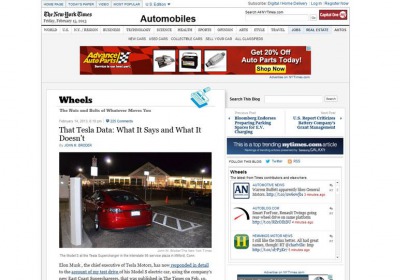NY Times reporter says he followed Tesla's advice
Fri, 15 Feb 2013
A New York Times reporter says he was following the advice of Tesla employees when he drove an electric Model S sedan beyond its indicated range in an effort to reach a recharging station.
Responding to a blog post by Tesla Motors CEO Elon Musk highly critical of his original article, Times reporter John Broder on Thursday said he did not set out to sabotage the test drive -- refuting one of Musk's most-damning points. Broder also refutes Musk's claim that he drove the car around a parking lot in a deliberate attempt to fully discharge the battery -- Broder says he was looking for the recharge station in a poorly lighted rest stop at night. And Broder says he accepted the guarantee from Tesla employees that the car had enough power to reach the next destination on his trip even though the battery indicator showed less than a full charge.
Yet Broder is also unable to reconcile his recollections of driving the Model S at lower speeds to conserve battery power, while data retrieved from the test car shows road speeds 15-20 mph above the reporter's claims.
The back-and-forth exchange between Musk -- who blasted Broder's original article on Feb. 8 as fake -- and the reporter and the newspaper has sparked plenty of comment on the Internet. As with the debate over electric vehicles in general, the debate over this incident is highly polarized, with staunch defenders for both Tesla and the New York Times.
The dustup began with Broder's original report, published Feb. 8, that detailed his drive from Washington, D.C., to Groton, Conn., in a Model S. The trip of some 350 miles was an effort to illustrate the usefulness of two newly installed Tesla Supercharger 480-volt recharge stations in the Northeast. The high-power rechargers could take the car's battery pack to a full charge in about an hour.
But Broder wrote of a trip filled with range anxiety as the car's displayed range dropped faster than the miles driven. The trip was taken with outside temperatures well below freezing. In Broder's report the car showed remaining range of 90 miles when parked for an overnight stop but the range had dropped to 25 miles the next morning with the temperature at 10 degrees.
Broder says he followed the advice of Tesla employees to condition the battery by running the car's heater to restore some of the lost range, although it actually cut the displayed range to 19 miles. During the trip he also followed Tesla's advice to drive slower, disable the cruise control and dial back the car's climate system to conserveenergy. At one point the car warns it is about to shut down. Once stopped it lacks enough power to release the electric parking brake. This prompted Broder to call a tow truck to get the Model S to a charging station.
Broder's report hit a raw nerve with Musk, who has not hesitated to react to reports critical of his electric cars. Musk claimed Broder's report was fake in a post on Twitter soon after it was published, and defended the car in several interviews. But he also talked with Broder via telephone and apologized for the outburst, the reporter says. Broder says Musk told him the distance between Supercharger stations should be 60 miles less than the current 200-mile gap, and offered him another test drive when more stations are built.
But Musk took to the Tesla blog on Feb. 13 to say that Broder did not tell the whole story and to suggest that the reporter was biased against electric vehicles based on stories published earlier. Musk wrote that Broder "did not accurately capture what happens and worked very hard to force our car to stop running."
Musk backed up his claims with charts of data retrieved from the test car -- and said Tesla would not comment further on the story.
The New York Times has stood by Broder, his original story and a followup article posted Feb. 12 on the newspaper's Wheels blog. Broder responded to Musk's charges in a second post on the Wheels blog on Feb. 14.
Broder writes. "It is fair to say that when I set out I did not fully appreciate how much of an effect the freezing temperatures would have on the travel range of the car."
He notes that he talked with Tesla officials before setting out on the trip, and talked with them more than a dozen times during the trip for advice on extending the car's range.
Regarding the discrepancy between Broder's reported speeds and data from the car, Broder writes: "I drove normally (at the speed limit or with prevailing traffic) when I thought it was prudent to do so. I do recall setting the cruise control to about 54 mph, as I wrote. The log shows the car traveling about 60 mph for a nearly 100-mile stretch on the New Jersey Turnpike. I cannot account for the discrepancy, nor for a later stretch in Connecticut where I recall driving about 45 mph, but it may be the result of the car being delivered with 19-inch wheels and all-season tires, not the specified 21-inch wheels and summer tires."
Comments on Broder's blog post point out that the difference in wheel size does not automatically mean that outer diameter of the tire was significantly different between the two -- the difference could be accounted for in the size of the tire sidewall.
Also, reporters from CNNMoney made the same trip this week with no reported problems, in warmer weather. Read that report here.
By Dale Jewett

